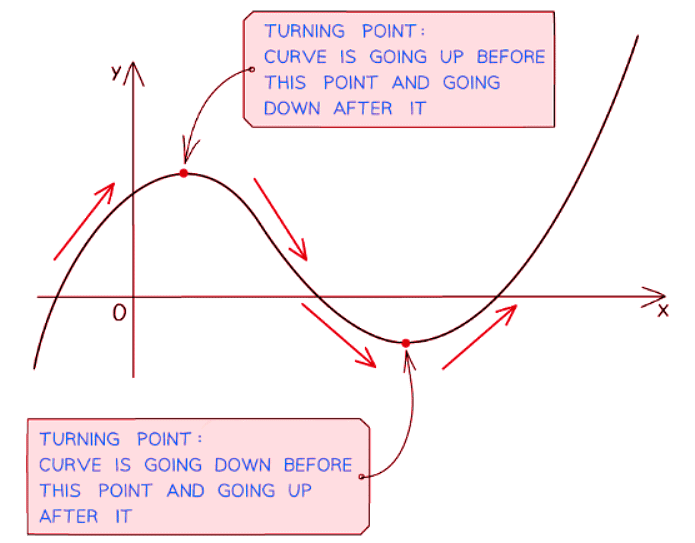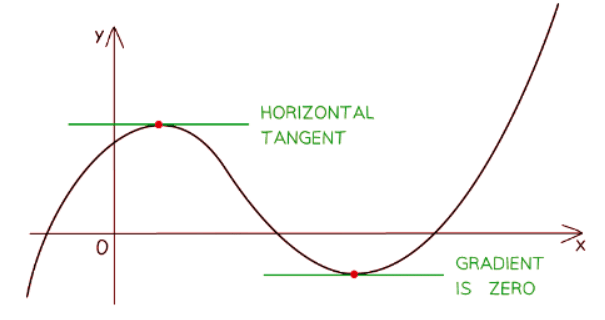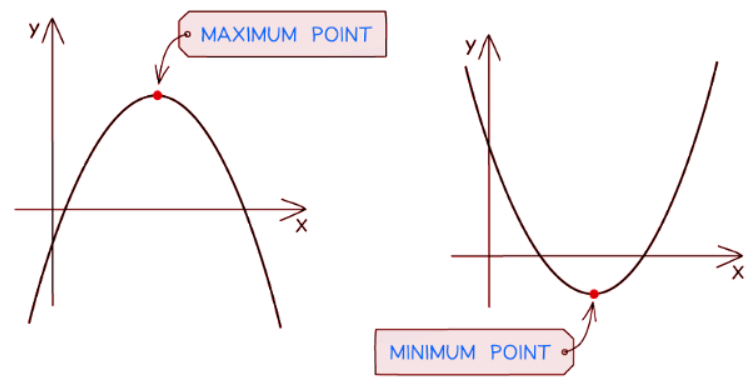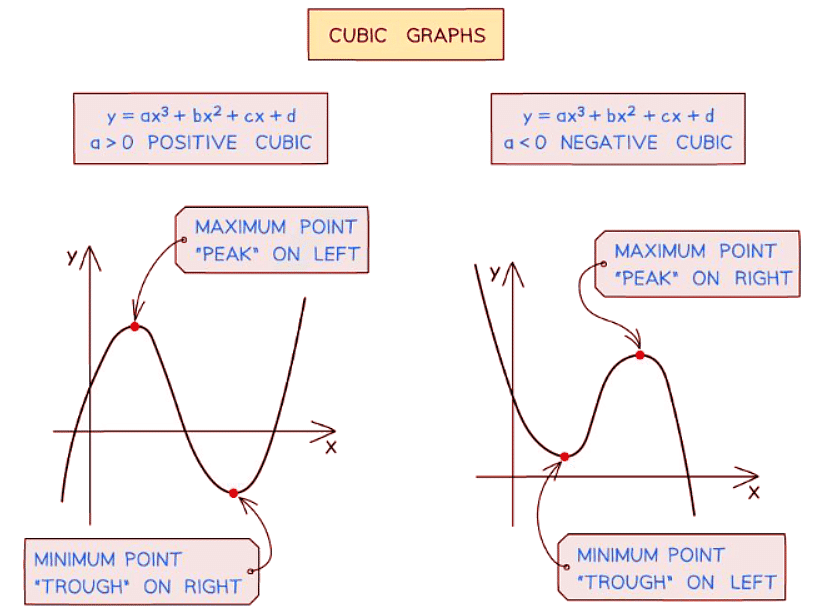Class 10 Exam > Class 10 Notes > Mathematics for GCSE/IGCSE > Applications of Differentiation
Applications of Differentiation | Mathematics for GCSE/IGCSE - Class 10 PDF Download
Finding Stationary Points & Turning Points
What is a turning point?
- A turning point can be thought of as a point where a curve transitions from moving upwards to moving downwards, or vice versa.
- These points are also referred to as stationary points. "Stationary" denotes that the gradient is zero (flat) at these points.

- At a turning point, the gradient of the curve equals zero.
- When a tangent is drawn at a turning point, it forms a horizontal line, which inherently has a gradient of zero.
- Therefore, substituting the x-coordinate of a turning point into the gradient function (also known as the derived function or derivative) will yield an output of zero.

How do I find the coordinates of a turning point?
- STEP 1: Determine the x-coordinate of the turning point by solving the equation of the gradient function (derivative) when it equals zero ie. solve

- x-coordinate: The value of x where the turning point occurs.
- STEP 2: Find the y-coordinate of the turning point by substituting the x-coordinate into the graph's equation, not the gradient function.
- y-coordinate: The corresponding y-value for the x-coordinate at the turning point.
Classifying Stationary Points
What are the different types of stationary points?
- You can identify different types of stationary points by observing the shape of a curve.
- There are two main types of stationary points, also known as turning points:
- Maximum points: These points represent peaks on the graph.
- Minimum points: These points represent troughs on the graph.

- Local Maximum/Minimum Points: These points are sometimes referred to as local maximum/minimum points because other parts of the graph may reach higher or lower values.
How do I use graphs to classify which is a maximum point and which is a minimum point?
- You can determine whether a point on a curve is a maximum or minimum point by:
- Observing the shape of the curve, either from a provided sketch or one drawn by yourself.
- Analyzing the equation of the curve.
- For parabolas (quadratics), it's straightforward:
- A positive parabola (with a positive x2 term) exhibits a minimum point.
- A negative parabola (with a negative x2 term) displays a maximum point.

- Cubic graphs are also easily identifiable:
- A positive cubic graph features a maximum point on the left and a minimum point on the right.
- Conversely, a negative cubic graph showcases a minimum point on the left and a maximum point on the right.

Question for Applications of DifferentiationTry yourself: What is a turning point?View Solution
How do I use the second derivative to classify which is a maximum point and which is a minimum point?
- The second derivative, denoted as
 represents the derivative of the derivative. To obtain this expression, differentiate the original expression dx/dy twice.
represents the derivative of the derivative. To obtain this expression, differentiate the original expression dx/dy twice. - An algebraic test to find the turning point without sketching involves the following steps:
- If the stationary point is at x = a, substitute x = a into the expression for
 to obtain a numerical value.
to obtain a numerical value. - If this value is negative
 the stationary point is a maximum point.
the stationary point is a maximum point. - If the value is positive
 the stationary point is a minimum point.
the stationary point is a minimum point. - If the value is zero
 the test is inconclusive, and further analysis or sketching is required to classify the stationary point.
the test is inconclusive, and further analysis or sketching is required to classify the stationary point.
- If the stationary point is at x = a, substitute x = a into the expression for
- A zero value could imply a maximum, minimum, or another type of stationary point. Therefore, returning to sketching the graph is necessary for classification.
The document Applications of Differentiation | Mathematics for GCSE/IGCSE - Class 10 is a part of the Class 10 Course Mathematics for GCSE/IGCSE.
All you need of Class 10 at this link: Class 10
|
38 videos|413 docs|19 tests
|
Related Searches















